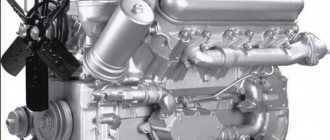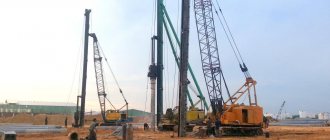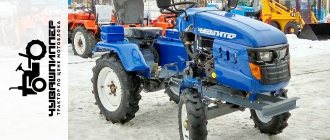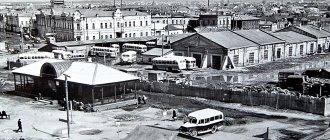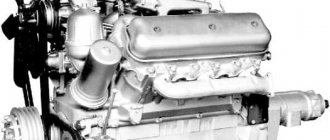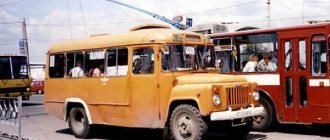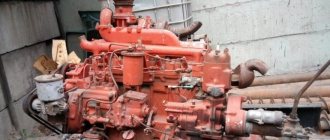- home
- Media center
- Articles
- YaMZ engine
Menu
- News
- Articles
- Video materials
- Photo materials
- Publication in the media
- 3D tour
11.12.2019
Yaroslavl Motor Plant (YMZ), one of the few enterprises of the former USSR that adequately survived the transition to market relations and not only did not lose its positions, but even strengthened them. Today YaMZ produces 13 families of diesel power units, and with modifications there are more than 250 of them.
Yaroslavl motors can be found on a wide variety of equipment. Information about these engines and their types will be of interest to the widest public.
Features of YaMZ engines
Yaroslavl Motor Plant - YaMZ, since the times of the USSR, has been the main enterprise for the production of diesel power units for a wide variety of equipment. Yaroslavl internal combustion engines (ICEs) power trucks, tractors, diesel locomotives, water transport, various special equipment, and are used as mobile power plants. Power units from Yaroslavl have proven themselves to be incredibly reliable and this is their main feature.
Another important feature of these engines is their phenomenal torque. Despite the fact that the power of YaMZ engines is not that great, their torque is simply gigantic. This is the most important parameter for heavy equipment, when there is no need to set speed records, but on the contrary, you need to remove as much cargo as possible from point “A” to point “B”.
Malfunctions
The YaMZ 236 and YaMZ 238 series engines are characterized by a number of typical faults characteristic of diesel power units. Having identified a malfunction, the owner needs to determine the reasons for its occurrence.
In order to correctly diagnose a defect, it is advisable to have the following information:
- The malfunction is permanent or appears periodically.
- The defect occurs when the engine starts; when the vehicle is moving at a constant speed or when braking (accelerating) by the engine; a certain operating mode (idling, hot or cold engine).
| SIGNS OF PROBLEM | REASONS FOR THE MALFUNCTION |
| 1. The MAZ and YaMZ engines do not start. | Ÿthe booster pump does not supply fuel; injectors are faulty; The glow plugs have failed. |
| 2. The MAZ car engine loses power. | Ÿfuel leakage in high pressure pipes; Ÿinsufficient dose of injected fuel; Ÿthe sprayer is damaged. |
| 3. Engine speed “floats”. | Ÿthe fuel supply system is aired; Ÿthe gas distribution mechanism is worn out; The injector spring has burst. |
| 4. Black smoke from the muffler. | Ÿlate fuel injection; Ÿthe spray needle is jammed; Ÿinsufficient compression in the cylinders; The injector spring has burst. |
| 5. Extraneous knocking noises in the engine. | Ÿearly fuel injection; Ÿconnecting rod and/or piston liners are worn out; Ÿincreased nozzle opening pressure; Ÿpiston rings are worn. |
"Long-liver" with an impeccable reputation
All the glory of Yaroslavl engine builders rests on just one power unit - YaMZ-236. This engine, developed back in the 50s, became the basis for most Yaroslavl engines; it was this engine that made YaMZ famous.
The YaMZ-236 power unit began to be produced in the early 60s. At one time, the engine was recognized as the best on Earth, even today, against the backdrop of Western innovations, it does not look outdated.
YaMZ-236 is a 6-cylinder, 4-stroke diesel engine with a volume of 11.5 liters. By boosting, installing turbocharging and other modernization options, it was possible to create a whole family of power units with a volume of up to 15 liters and a power of up to 420 hp. With.
Next, Yaroslavl began producing diesel engines of more complex configurations, increasing the number of cylinders, bringing it to 12 on top-end engines. Thus, they managed to satisfy almost 100% of our country’s need for diesel engines.
Of course, today they have been squeezed out of the market by Western competitors. But the huge range of products, as well as their reputation, allows YaMZ to feel confident in the market and look to the future with confidence.
History of YaMZ engines
Yaroslavl Motor Plant is one of the oldest mechanical engineering enterprises in Russia. The plant was founded before the revolution by the famous Russian industrialist V. A. Lebedev. The enterprise was founded as an automobile enterprise, and after the October Revolution no one began to repurpose it. The main specialization of the plant was the production of heavy-duty trucks.
1933 was an important year for the plant. It was this year that the plant developed, for the first time in the USSR, a diesel power unit. It was a motor called “Koju”. The year 1933 can be considered the beginning of the era of Yaroslavl engine building.
Immediately after the war, YAZ-204 and YAZ-206 engines with a power of 110-220 hp were developed at YaAZ (as the plant was called before the war). pp., for heavy-duty dump trucks. Despite the fact that the engines were more than successful, already in the 50s they did not meet modern requirements, and there was a need to replace them. True, the YAZ series engines were not discontinued from production; they were assembled until the end of the 70s.
In the early 50s, due to the ever-increasing needs of the national economy for diesel power units, it was decided to stop producing cars at the plant and focus exclusively on engines. Since that time, the plant received its current name YaMZ.
As already written above, in the late 50s, and specifically from 1958 to 1961, under the leadership of the outstanding Soviet designer Georgy Dmitrievich Chernyshev, the YaMZ-236 engine was developed. Since the beginning of the 60s, this power unit and its variants have become the main products of the plant.
Until the end of the 60s, YaMZ-236 remained the main product of the enterprise, until at the end of the 60s, for KamAZ, a family of in-line 6-cylinder engines YaMZ-740 and 741 was developed.
In principle, in the 60s, YaMZ covered all the USSR's need for diesel engines for trucks, however, there was still heavy special equipment that also needed powerful, reliable engines. In the 70s, YaMZ developed 12-cylinder engines of the YaMZ-840 series. These power units began to be installed on the Kirovets K-700 and K-701 tractors. With this set of engines, YaMZ met the collapse of the Union and entered the market.
The market economy required new approaches. To meet new requirements, it was necessary to develop new engines that would comply with global environmental standards Euro - 1, 2, 3. This task was brilliantly completed by the Yaroslavl team.
Well, the latest development from Yaroslavl was the YaMZ-780 power unit. This 6-cylinder engine was developed for the Boomerang and Kurganets-25 family of promising armored vehicles.
YaMZ - Yaroslavl Motor Plant (YMZ) - history of YaMZ, information on YaMZ, photo of YaMZ
History of the engine plant - facts from the archives
Almost a century ago, with the permission of the Russian government, the Russian industrial figure V.A. Lebedev. A large number of land plots were acquired in Yaroslavl and construction began on what was then called Automobile. To be precise, it was 1916 - considered the year of foundation of the Yaroslavl Motor Plant .
the first Soviet three-ton truck - Ya-3, 1921
The time of opening and launching the plant was difficult, post-revolutionary. The plant was supposed to breathe life into the “disabled people on wheels” that the young republic inherited from the past. Both the front and the rear were in dire need of cars. The plant did not really work for the first years and practically did not produce any products. Only after the transformation of the plant into YAGAZ 3 (Yaroslavl State Automobile Plant N3) and the development of new capacities, YagAZ (later YaAZ) began to produce heavy-duty dump trucks, note the first in the union. They showed the promising future of the plant by passing the exam at the first three five-year plans with honor. "Magnitka", Kuzbass, DneproGES still keep the memory of the trouble-free "workers" of YaAZ.
During this period, the Yaroslavl Motor Plant began to actively increase its workforce and attract young and worthy specialists to its offices. Over the course of 5 years, and you remember that the union practiced the “Five-Year Plan” model, the number of employees at the engine plant increased 5 times. This was the time from 1925 to almost pre-war times. Then the chief designer at the plant was Vladimir Vasilyevich Danilov, an ardent innovator and engineer from God. It was under his leadership, and in most cases with direct participation, that equipment that was not previously produced in the union was designed. These include tractors and double-decker trolleybuses. It is worth noting that the production of trolleybuses was rapidly increased, so YATB-4 trolleybuses operated in more cities: Moscow, Donetsk, Yekaterinburg, Kiev, Kutaisi, Rostov-on-Don, Tbilisi, Kharkov, Chernivtsi, Sevastopol, Odessa. Unfortunately, now only archival memories of YATB-4 remain. Of course, it is worth mentioning that the designers were not averse to adopting already existing industry developments. Thus, the acquisition of 140 German engines with the right to produce them at YAZ was the result of one trip to an international exhibition in 1929.
YaMZ winner of the Order of Lenin and the Stalin Prize
A difficult war time is coming for the country. In 1941, the Soviet government planned a radical reconstruction of the Yaroslavl Automobile Plant with the goal of mass production of new seven-ton trucks. Yaroslavl designers began work on the project of the promising YAG-14 truck, intended for production at the renovated plant. The prototype for it was the American truck "Jimsy-803" with a diesel engine with a power of 110 hp. By June 1941, the project was almost ready, but the German attack on the USSR disrupted all plans. YaAZ switched to the production of shells, machine guns and tracked artillery tractors. This was the period of the 40s and 50s. The plant’s staff decides to suspend the early work on promising designs and, using their experience in creating heavy multi-axle equipment, masters the production of artillery tractors as soon as possible. And together with the Nizhny Novgorod Automobile Plant, the first Soviet serial amphibious tank was developed. True, the production and release of the tank was transferred entirely to Nizhny Novgorod. And at the same time, the Yaroslavl Motor Plant, and then it was still YaAZ, begins to master the production of the first “super heavyweights” - three-axle vehicles of the YaAZ-210 series with a carrying capacity of 12 tons.
artillery tractor Ya-12, 1942
In 1947-1951, Yaroslavl residents were the first in the USSR to master the serial production of two-stroke automobile diesel engines YaAZ-204 and YaAZ-206 with a power of 110-220 hp. With. for YAZ, MAZ, KrAZ vehicles, specialized vehicles, ZIL-154 buses, pumping units, etc. The Stalin Prize was received for the development of these engines in 1949 . From this moment on, the engine plant received a new purpose. This was in 1958. The course of a country is determined not only from above, but also by the needs of the citizens of this country. Then the country needed many different cars, meeting in each case the specific operating conditions of those sectors of the economy for which they were intended. In other words, the automotive industry of those years set a course for expansion and clear specialization of production. So a decision was made at an internal meeting of the council to specialize the plant in the production of powerful diesel engines. YaAZ turned into YaMZ .
Honored State Prize of the USSR
Yes, this was in 1972. 7 plant employees and the head of the TsNIAAMI sector were awarded for the creation of a unified family of multi-purpose YaMZ engines, the organization of their highly mechanized production, the development and implementation of a quality management system. In general, in the post-war period, especially at the end of the five-year plan, the Yaroslavl Motor Plant has good trends in development and expansion of the range of activities . The move away from the production of special equipment itself and the concentration of power and “minds” on the development of engines gave a positive result. During that time, one of the most popular products, which will continue to be the pride of the plant, was developed and produced - the YaMZ-236, YaMZ-238 and YaMZ-240 engines.
| YaMZ 238nd5 engine. photo 2012 |
These were more economical four-stroke diesel engines that replaced the outdated YaAZ-204. By the way, the USSR State Prize was awarded for the development of the YaMZ 238 engine. At this time, active development of power units for specialized equipment begins. Often in quantities of several dozen copies. Then YaMZ found its main consumer - it was the Kama Automobile Plant and their brainchild KamAZ. The quality of the engines produced was constantly growing, as the YaMZ team paid primary attention to increasing the service life of the engines. Based on serious research, a set of design and technological improvements was developed. All this made it possible to increase the service life of the YamZ engine to 10,000 operating hours. Which is practically 3 times more than the resource of the previous modification of the unit. So, in 1971, the Yaroslavl Motor Plant became the head enterprise of the Avtodiesel production association . Which, of course, influenced its further development and, to a small extent, changed the strategy of YaMZ’s behavior in the automotive industry market.
Time for great achievements
The engine plant entered new times with the support of the Avtodiesel concern. This meant both a course correction and an inevitable change in the management team. Vitaly Alekseevich Doletsky (1982) is appointed director of the motor plant. A person of strong acumen and good management abilities. He went through all the workshops of the plant - he began by working as an assistant foreman in the assembly shop, then YaAZ, going through the ranks of workshop manager and chief engineer of the plant (1965). In the 1980s, YaMZ broke all records - the maximum production volume was reached: about 140 thousand diesel units were produced at the motor plant per year. During these years, the engine plant took an active life in the social sphere - this included the construction of the 14th microdistrict of the Northern residential area of Yaroslavl, and active cooperation with the Polytechnic University. At this time, the motor industry has a colossal list of consumers of its products - MAZ, BelAZ, MoAZ, MZKT, KrAZ, UralAZ, ZIL, BAZ, LAZ, KZKT, IZ, Rostselmash, Krasnoyarsk Combine Harvester, "Voronezhsky", "Kovrovsky Excavator", "Muromsky", “Lyudinovsky Diesel Locomotive Building”, “Ivanovsky Crane Chelyabinsk Autodiesel”, in the automotive market of the country and the CIS.
Yaroslavl Motor Plant, main entrance, 2010.
Our time and the well-deserved Prize of the Government of the Russian Federation
Unfortunately, the transition to a market economy dealt a strong blow to YaMZ: this was a sharp decline in the production volume of the main buyers of engines in the 1990s, some of whom also moved abroad, and the beginning of competition with Western manufacturers. However, the plant managed to survive and resume stable operation and production development. Everything that happened in the country at the beginning of the 90s left its mark on the history of such an industrial giant as the Yaroslavl Motor Plant. Thanks to the acumen and perseverance of director V.A. Doletsky and the excellent organizational skills of his deputy V.E. Savelyev, the engine plant did not cross the brink of ruin. The board of directors decided to change the status of the enterprise and since 1993 the engine plant has been called OJSC Avtodiesel Yaroslavl Motor Plant . In this, although without war, it is still an economically difficult time with the production of special power units for piecemeal types of equipment - such as the rocket and space complex, and even stationary power units and electric generators. During this period, the plant's security service recorded the highest level of violations of internal regulations and labor regulations in the entire history of the plant. Fortunately, for six years of hard work (from February 1996 to December 2002) V.E. Savelyev and his team managed to bring YaMZ out of the economic crisis, returning the company to its former authority and respect. Hundreds of thousands of cars, mainline trains, dump trucks, timber carriers - more than 287 types of products are equipped with Yaroslavl engines. In many ways, the rise of YaMZ is associated with the figure of the general director, deputy of the State Duma of the Yaroslavl Autonomous Okrug, Vladimir Egorovich Savelyev. And with the development of production of Euro-2 class engines, the crisis completely disappeared. Then, in 2003, YaMZ was awarded the Russian Government Prize for the development and development of production of multi-purpose diesel engines, which for the first time in Russia met international environmental standards of the Euro-4 class.
Confident steps of a successful and modern enterprise
In modern history, YaAZ has become the Yaroslavl Motor Plant of the GAZ Group, as it has been called since 2001 - then the merger of Avtodiesel OJSC (YaMZ) with RusPromAvto LLC, which was subsequently transformed into the GAZ Group, took place. The merger was successful and beneficial for both parties. YaMZ is preparing for serial production of Euro-4 environmental class engines. The company completed bench tests in 2012. V-shaped diesel eight-cylinder engines YaMZ-6585 and YaMZ-6565 were tested. New YaMZ engines are equipped with Common Rail fuel equipment based on a high-pressure fuel supply pump manufactured by YAZDA. The engine plant applies the practice of continuity, so engines are modernized while maintaining overall dimensions, which allows them to be used in mass-produced vehicles without changing the design of the equipment. The power of a modern YaMZ engine reaches 450 hp.
|
|
General Director of Yaroslavl Motor Plant - Director of the Power Units Division of GAZ Group Viktor Kadylkin (by the way, appointed director in 2003) about
YaMZ as the pride of the fatherland and the support of the engine industry
In a word, Yaroslavl residents have something to be proud of. Although, at the same time, there is nothing particularly remarkable in these achievements. And in some places this is even natural. Putting aside production volumes, stages of modernization and innovations in the automotive industry, we can safely say that the Yaroslavl Motor Plant has followed a path characteristic of the entire automotive industry, both Soviet and modern Russian. And its tasks, at each stage of history, were determined by the rapid development and urgent requirements of our national economy, and in the modern world, other areas of mechanical engineering.
Dry facts and dates YaMZ
- years 1916-1925
- years 1925-1930
- years 1930-1950
- years 1960-1980
- years 1990-2000
- Nowadays
years 1916-1925
- 1916 - an automobile plant of the joint-stock company “V. A. Lebedev"
- 1918 - the first automobile repair plant with the status of a defense industry enterprise was organized on the basis of the Lebedev plant.
years 1925-1930
- 1925 - the first Soviet heavy trucks were assembled - 3-ton Ya-Z
- 1926 - 1st Automobile Repair Plant was reorganized into the Yaroslavl Automobile Plant
- 1928 - Production of Ya-4 began. Load capacity 4 tons;
- 1929 - Production of the Ya-5 began. The first batch of Ya-6 bus chassis was manufactured
years 1930-1950
- 1931 - the first domestic 8-ton car was produced - the three-axle YAG-10
- 1932 - a sample of a 12-ton 4-axle truck with two steered axles was built - YAG-12
- 1933 - prototypes of the first domestic automobile diesel engines were created
- 1934 - prototypes of the 100-seater YaA-2 bus were built
- 1935 - production of the first dump trucks began - YAS-1 with a lifting capacity of 4 tons
- 1936 - the first Soviet trolleybuses YaTB-1 were released
- 1942 - artillery tractor YA-12
years 1960-1980
years 1990-2000
Nowadays
Design and technical characteristics of modifications of YaMZ engines
As mentioned above, today YaMZ produces 13 families of diesel engines:
- YaMZ-236;
- YaMZ-238;
- YaMZ-240;
- YaMZ-534;
- YaMZ-536;
- YaMZ-650;
- YaMZ-656;
- YaMZ-658;
- YaMZ-7511;
- YaMZ-7601;
- YaMZ-770;
- YaMZ-840;
- YaMZ-850.
Next, let's look at each of them in more detail:
Engine YaMZ-236
This legendary engine is built according to the V6 scheme. The working volume of all power units of the YaMZ-236 series is 11.15 liters.
The cylinder camber is 90°.
Piston stroke – 140 mm;
Cylinder diameter – 130 mm.
Today, depending on the modification, engines with power from 150 to 300 hp are produced. With.
As for environmental standards, there are modifications that comply with standards from Euro-0 to Euro-3.
The scope of application of these motors is the widest, in addition to cars, YaMZ-236 is used as a drive for pumps, compressors, portable power stations, as well as a power unit for boats. The YaMZ-236G modification has found wide application on excavators, tractors, and other road equipment. YaMZ-236D was immediately created exclusively for tractors, where it is used. Well, YaMZ-236DK was adapted for grain harvesters.
Engine YaMZ-238
This is, in fact, an 8-cylinder version of the YaMZ-236 engine. The 238th engine is made according to the V8 design. This was done very simply, one cylinder was added to the V6 engine. Thus, the volume of the power unit became 14.87 liters, and the power increased to 235 hp. With.
All other technical parameters are exactly the same as those of the younger YaMZ-236 engine. Depending on the boost, the power of the 238 engine can reach 420 hp. With.
YaMZ-240
This is another version of YaMZ-236. Only it can be called extreme; in this power unit the number of cylinders was increased to 12.
The volume of these engines is 22.3 liters, and the power ranges from 300 to 420 hp. With.
All motors comply with environmental standards Euro – 0.
The scope of application of these motors is not as wide as, for example, previous power units. Basically, all modifications of the 240 are used on BelAZ mining dump trucks. The only exception is the modification YaMZ-240BM2-4, which was created specifically for the Kirovets K-701 tractor.
YaMZ-534
Despite the fact that the power units of the YaAZ-204 series were already considered obsolete in the 50s and were not used in cars, they were not removed from production. These motors have also found application in mobile power plants, boats and other specialized equipment. However, by the end of the 70s, their characteristics, and primarily in terms of fuel consumption, no longer satisfied customers. It was then that the YaMZ-534 series engines were developed to replace them.
True, due to the collapse of the Union, their development was delayed for almost 30 years. In the 80s, the residents of Yaroslavl carried it out independently. In the 90s, with the advent of all kinds of environmental standards, Western partners were brought in for this purpose. Specifically, the company AVL List.
As a result, work on these power units was completed in the 21st century. Despite such a long development period, the engine turned out to be the most modern. It immediately complied with Euro-4 environmental standards. And now work is underway on its modification that meets Euro-6 standards. In 2010, YaMZ received the Adam Smith Institute Award for this engine.
Like their predecessors, these power units are in-line 4-cylinder diesel engines. Their volume was 4.43 liters. And the power ranged from 136 to 215 hp. s., at 2300-2600 rpm, depending on the modification.
All power units of this family are equipped with turbocharging.
Piston stroke – 105 mm;
Cylinder diameter – 128 mm.
The most interesting, advanced modification of this power unit is the YaMZ-534 CNG. This modification was originally designed to run on natural gas.
Today, various variations of the YaMZ-534 are installed on the most modern Russian trucks, such as Lawn Next, Ural-432065, Tiger armored car and others.
YaMZ-536
This is essentially a 6-cylinder version of the previous engine, the 534 series. Due to the additional two cylinders, the working volume of the power unit increased to 6.65 liters. Power ranges from 240 to 320 hp. pp., depending on modification. The remaining technical parameters are similar to those of the previous motor.
These power units are designed for installation on heavier trucks and buses. Such as MAZ, Ural and LiAZ buses.
YaMZ-650
Another one of the newest Yaroslavl engines. This power unit is not an independent development, it is a licensed version of the well-proven French Renault DCi11 engine. The license for it was purchased in 2006. Along with the license, the Yaroslavl residents also received French equipment, and their specialists underwent training and internships at French enterprises.
YaMZ-650 is an in-line 6-cylinder diesel power unit with a volume of 6.65 liters. Power, depending on the modification, ranges from 285-420 hp. With.
The engine meets Euro-4 environmental standards.
The main area of use of these diesel engines is specialized and agricultural machinery.
YaMZ-656
This is the latest modification of the famous old man YaMZ-236. The engine differs from its progenitor by the CommonRail direct fuel injection system. Thanks to this, it was possible to achieve compliance of this power unit with Euro-5 environmental standards. Although older modifications that are still in production comply with Euro 3 and 4 standards.
The scope of application of these engines is the most modern domestic trucks, truck tractors and buses.
YaMZ-658
This is an 8-cylinder version of the previous power unit. Like its older counterpart, YaMZ-238, the engine has a volume of 14.86 liters. The power of different engine modifications ranges from 330-400 hp. With. All engines of this series are equipped with a TKR-100 turbocharger.
The main consumer of these engines is Belarus. There they are installed on heavy MAZ trucks, military MZKT-69221 and tractors of various models.
YaMZ-7511
YaMZ-7511 is the most modern modification of the 8-cylinder YaMZ-238 engine. The engine is built according to the V8 scheme. Its power ranges from 360-420 hp. With. All power units in this series are equipped with turbocharging.
The main area of application of these power units is special and military equipment. YaMZ-7511 motors can be found on military tractors, anti-aircraft missile systems, ballistic missiles, products of the Minsk Wheel Tractor Plant and other special equipment.
YaMZ-7601
Another product of deep modernization of YaMZ-236 engines. As a result of boosting, the engine power was increased to 300 hp. With.
The engines of this series have a new built-in liquid-oil heat exchanger, a new, more powerful water pump, liners and motor pistons have also undergone changes, as a result of which their cooling has improved.
These power units can be found under the hood of Ural onboard vehicles, as well as in the engine compartment of buses from the Minsk Auto Plant MAZ.
YaMZ-770
This is one of the latest developments of the Yaroslavl Plant. This power unit is still among the most promising. The technology for this engine is just being developed.
As for the technical characteristics, the engine is an in-line 6-cylinder, with a displacement of 25.86 liters, and a power of 550 to 800 hp. With.
Important innovative components of this power unit are:
- CommonRail battery direct fuel injection system;
- Exhaust gas recirculation system;
- 24-valve cylinder head, with overhead camshafts;
This motor meets the most stringent environmental requirements of Euro-6.
YaMZ-840
And this is one of the most powerful Yaroslavl serial power units. It is made according to the V12 scheme. Its displacement is 25.86 liters and its power ranges from 500 to 694 hp. With. The engine was developed back in the 70s and therefore meets only Euro-0 and Euro-1 environmental standards.
The scope of application of this family of power units is, first of all, BelAZ mining dump trucks with a load capacity of 70 tons and specialized military equipment, for example, two-link tracked all-terrain vehicles for the Far North.
YaMZ-850
The last family of power units in our review are motors that can be considered an upgraded version of the previous power unit. Like the YaMZ-840 engine, the 850 has a volume of 25.86 liters. All engines are equipped with turbochargers.
The scope of application of these power units are heavy bulldozer tractors and pipe layers, as well as various powerful special equipment, such as compressors and portable power plants.


